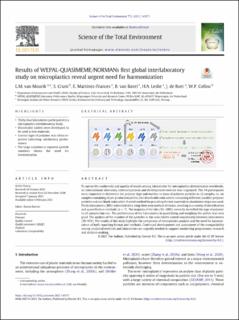| dc.contributor.author | van Mourik, L.M. | |
| dc.contributor.author | Crum, S. | |
| dc.contributor.author | Martínez-Francés, E. | |
| dc.contributor.author | van Bavel, B. | |
| dc.contributor.author | Leslie, H.A. | |
| dc.contributor.author | de Boer, J. | |
| dc.contributor.author | Cofino, W.P. | |
| dc.date.accessioned | 2021-07-16T10:12:19Z | |
| dc.date.available | 2021-07-16T10:12:19Z | |
| dc.date.created | 2021-04-14T14:36:06Z | |
| dc.date.issued | 2021 | |
| dc.identifier.citation | Science of the Total Environment. 2021, 772, 145071. | en_US |
| dc.identifier.issn | 0048-9697 | |
| dc.identifier.uri | https://hdl.handle.net/11250/2764650 | |
| dc.description.abstract | To survey the conformity and quality of results among laboratories for microplastics determination worldwide, an international laboratory intercomparison and development exercise was organized. The 34 participants were requested to determine the polymer type and number or mass of polymer particles in 12 samples, i.e. six samples containing of pre-production pellets, five dissolvable soda tablets containing different (smaller) polymer particles and one blank soda tablet. A novel method for providing the test materials in aluminium strips was used. Thirty laboratories (88%) submitted data using their own method of choice, resulting in a variety of identification and quantification methods (n = 7). The majority of the labs (53–100%) correctly identified the type of polymer in all samples but one. The performance of the laboratories in quantifying and weighing the pellets was very good. The analysis of the number of the particles in the soda tablets varied considerably between laboratories (29–91%). The results of this study highlight the complexity of microplastics analysis and the need for harmonization of both reporting format and methods. Continued development and assessment of the comparability among analytical methods and laboratories are urgently needed to support monitoring programmes, research and decision-making. | en_US |
| dc.language.iso | eng | en_US |
| dc.publisher | Elsevier | en_US |
| dc.rights | Navngivelse 4.0 Internasjonal | * |
| dc.rights.uri | http://creativecommons.org/licenses/by/4.0/deed.no | * |
| dc.title | Results of WEPAL-QUASIMEME/NORMANs first global interlaboratory study on microplastics reveal urgent need for harmonization | en_US |
| dc.type | Peer reviewed | en_US |
| dc.type | Journal article | en_US |
| dc.description.version | publishedVersion | en_US |
| dc.rights.holder | © 2021 The Authors | en_US |
| dc.source.pagenumber | 8 | en_US |
| dc.source.volume | 772 | en_US |
| dc.source.journal | Science of the Total Environment | en_US |
| dc.identifier.doi | 10.1016/j.scitotenv.2021.145071 | |
| dc.identifier.cristin | 1904049 | |
| dc.source.articlenumber | 145071 | en_US |
| cristin.ispublished | true | |
| cristin.fulltext | original | |
| cristin.qualitycode | 2 | |

